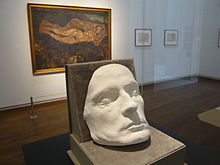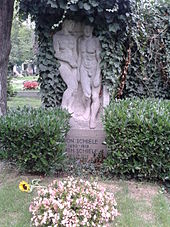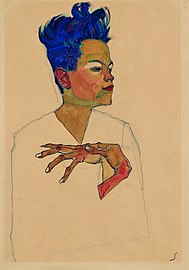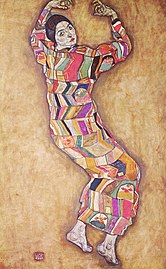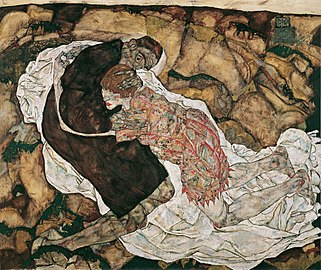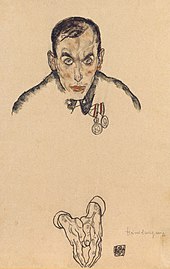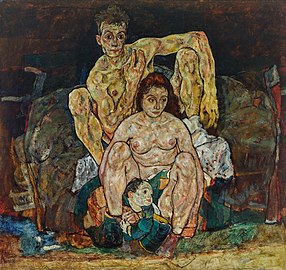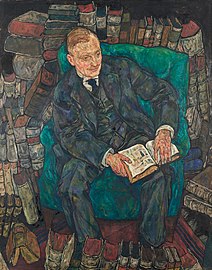Egon Schiele
Egon Leo Adolf Schiele Ludwig (* 12. June 1890 in Tulln , Austria-Hungary , † 31 October 1918 in Vienna ) was an Austrian painter of Expressionism . Along with Gustav Klimt and Oskar Kokoschka, he is one of the most important visual artists of Viennese modernism .
Life
Schiele was the third child of Adolf Eugen Schiele (1850–1905) and his wife Marie Schiele (1862–1935), née Soukup, from Krumau in southern Bohemia . Elvira (1883–1893), the eldest of his three sisters (the other two were Melanie, 1886–1974, and Gertrude, 1894–1981), died at the age of ten. Melanie worked as a milliner and married her work colleague Gustav Schuster (1884–1933) in 1923; the youngest sister Gertrude married the artist and friend Schiele's Anton Peschka in 1914 . She was a model for Egon Schiele in his early days.
Egon Schiele's father died of syphilis on New Year's Day 1905 . Then Egons godfather and uncle Leopold Czihaczek (1842–1929) became his guardian and sponsor. This event was formative for Schiele's life and art. Schiele attended primary school in Tulln in 1901 , then the Realgymnasium in Krems and from 1902 the Gymnasium Klosterneuburg a few kilometers north of Vienna. During this time he began to draw, primarily episodes from the railway world.
The art teacher Ludwig Karl Strauch and the Klosterneuburg artist Max Kahrer discovered his extraordinary talent there and supported him in his application for the Vienna Academy of Fine Arts , to which he was admitted in 1906 at the age of 16.
This professional goal did not correspond to the ideas of his guardian and therefore already led to arguments with the uncle. At the academy, Schiele studied painting with Christian Griepenkerl . At first enthusiastic, but then tired of the rigid everyday life at the academy and the conservative views of individual teachers, Schiele left the academy after two years and founded the Wiener Neukunstgruppe with a few fellow students .
In 1907 Schiele sought his first personal contact with Gustav Klimt , who became a paternal friend and mentor to him. He also moved into his first own studio in Vienna , at Kurzbauergasse 6 in Leopoldstadt , on the edge of the Vienna Prater . In 1908 Schiele took part in a public exhibition for the first time, in the Imperial Hall of Klosterneuburg Abbey . It was here that Heinrich Bensch, a later collector and pioneer of Egon Schiele, became aware of him. Schiele celebrated first successes in 1909 with the exhibition of his works, which are all very reminiscent of Gustav Klimt's style, as part of the Neukunstgruppe in the “Great International Art Show” in Vienna. In addition to artists such as Gustav Klimt and Oskar Kokoschka , Schiele was able to make a name for himself with the art critic Arthur Roessler , who played a decisive role in Schiele's advancement through his excellent contacts. Through Roessler's mediation, Schiele met the art collectors Carl Reininghaus and Oskar Reichel , who financially secured his debut in the Viennese art scene and provided him with numerous commissioned works. The art collector Franz Hauer was also one of his sponsors . Schiele moved away from decorative Art Nouveau through his brief friendship with Max Oppenheimer , whom he met in 1909. Around this time there was a clear turn to Expressionism in his work. The Neukunstgruppe exhibited for the first time in December 1909 in the salon of the art dealer Gustav Pisko in Vienna.
Schiele's artistic self-discovery seemed to be complete at this time, and in many of his works the borderline experiences between eros and death became very clear. Because of bohemian attitudes, as his uncle called them, Leopold Czihaczek resigned from guardianship. This led to serious financial problems at Schiele. A first solo exhibition of Schiele's work was shown in 1911 at the Miethke gallery in Vienna. In the same year he got to know the Munich art dealer Hans Goltz and in November 1911 he was accepted by the artists' association "Sema", which included Alfred Kubin and Paul Klee.
In 1910 he lived with Liliana Amon in his studio on Alserbachstrasse in the 9th district. Satisfied with the hype in the capital, Schiele moved away from Vienna in 1911. Together with Wally Neuzil (Wally = Walburga), his best-known model, he moved to Krumau ( Český Krumlov in Czech ), the birthplace of his mother. An artistically extremely productive period began there for Schiele. The old town of Krumau became his most popular motif at that time. But the population found Schiele's lifestyle objectionable; The trigger was probably the wild marriage with Wally Neuzil and the visits by children to Schiele's studio.
That is why they moved to Neulengbach that same year and rented an apartment in Au am Anzbach . In Neulengbach he was taken into custody for alleged kidnapping and desecration of a girl; the charge of kidnapping turned out to be unfounded; however, the court sentenced him for "disseminating immoral drawings". Schiele spent a total of 24 days in prison, where he drew a few sketches of his stay.
In 1912 he returned to Vienna. Together with the Neukunstgruppe, works were shown in the Budapest Künstlerhaus. At the "Blauer Reiter" exhibition, works by Schiele were presented in the Hans Goltz Gallery in Munich . The Folkwang Museum in Hagen (North Rhine-Westphalia) showed a representative exhibition, including pictures by Egon Schiele.
Thanks to his patron and fatherly friend Gustav Klimt , he was able to quickly gain a foothold again despite the bad reputation that had preceded him to Vienna. Klimt established important contacts for him with collectors and gallery owners, including one of his most important collectors, the industrialist August Lederer . He again celebrated great success in the Austrian art scene. For example, seven oil paintings, including the "Hermits", were shown in an exhibition by the Vienna Hagenbund .
In October 1912 Schiele rented a new studio at Hietzinger Hauptstrasse 101, which he was to keep until June 1918, almost until his death. His mentor Klimt had his studio nearby. The 13th district, Hietzing, is still considered a better area in Vienna today; u. a. the imperial residence of Schönbrunn Palace was located in this district. In 1913 he was made a member of the Association of Austrian Artists, of which Gustav Klimt was president. Several exhibitions in Austria and Germany followed in March.
By 1916 Schiele himself submitted theoretical and literary texts several times in a row to the Berlin magazine Die Aktion . In 1916 it brought out its own Egon Schiele booklet (No. 35/36). From 1914 onwards he increasingly occupied himself with woodcuts and etchings, the techniques of which he had learned from the painter and graphic artist Robert Philippi . On June 21, 1915, Schiele was called up for military service as a one-year volunteer in the kuk Infantry Regiment No. 75 . Shortly before he was transferred to Prague, Schiele married his long-time girlfriend Edith Harms on June 17, 1915; she lived with her sister Adele and her parents across from his studio, at the address Hietzinger Hauptstrasse 114. Edith asked Schiele to break with Wally Neuzil, which he carried out with a heavy heart after both women had refused a love triangle.
From May 1916 Schiele served as a soldier in the provisions office of the prisoner- of- war camp in Mühling near Wieselburg in Lower Austria, and during this time he painted a single oil painting near Purgstall, The decaying mill , which he found in the Erlauftal valley and its owner, called up for military service, not repairs Could take care of floods.
After his basic military training and the associated transfers, Schiele came back to Vienna in 1917, where he was initially employed as a clerk (military administrative clerk) for the " kuk Konsum-Anstalt for the gagists of the army in the field". He always met benevolent superiors who also gave him the opportunity for artistic work; “Wherever he was, his service was more than easy”. During this time he portrayed Russian prisoners of war and Austrian officers.
Nevertheless, Schiele felt that he was wrongly manned and made the following request to the army command: My occupation does not correspond to my artistic qualifications. I believe that there would be an opportunity for me to find appropriate employment and use as part of my military service in the Army Museum , so that my powers as a painter and artist do not have to lie idle and I could use what I can really do in my fatherland . At the beginning of 1917 he and Albert Paris Gütersloh were commissioned to select works by young artists for the “War Exhibition 1917” in the Vienna Prater .
On April 29, 1918, he was posted to the Imperial and Royal Army Museum for a period of six months , where he and Anton Faistauer organized war picture exhibitions and pursued his painting. The director there, Wilhelm John , granted Schiele, who, after the years of service that had primarily been spent in the office up to now, "was eager to catch up on what had been missed", not only here but also his minor official duties, the freedom for his artistic work.
Gustav Klimt died on February 6, 1918. The next day Schiele made three drawings by Klimt in the death chamber of the General Hospital . At this point in time, Schiele rose in the Viennese art scene; the 49th exhibition of the Vienna Secession was dedicated to him. He exhibited 19 large paintings and 29 drawings . The picture "Edith Schiele sitting" was acquired by the director of the Modern Gallery (1915–1938), Franz Martin Haberditzl . Further exhibitions and successes followed, and Schiele's ideas about setting up an art school also emerged at this time. The evaluation of his work in the press was also increasingly positive.
Schiele last lived and worked since July 1918 in Alt-Hietzing , 13th, Wattmanngasse 6, closer to the district center. Towards the end of the war, in autumn 1918, the catastrophic Spanish flu hit the Austrian capital. Edith Schiele, six months pregnant, succumbed to this disease on October 28th in her apartment on Wattmanngasse. Egon Schiele was also infected and died, only 28 years old, on October 31, 1918 in the apartment of his wife's family in Vienna 13th , Hietzinger Hauptstrasse 114. The creation of his undated and unsigned painting "Kauerndes Menschenpaar (the family)" is incorrectly dated to the time between the day of Edith Schiele's death and the day of Egon Schiele's death. In fact, the picture was probably made in 1917/1918. It was first published in March 1918 on the occasion of the XLIX. Exhibition of the Vienna Secession shown to the public.
Egon Schiele was buried next to his wife in an honorary grave in the Ober-St.-Veiter Friedhof (group B, row 10, number 15/16) in his last residential district in Vienna. In 1968 his sister-in-law Adele Harms, who died at the age of 78, was also buried here.
Afterlife
In 1930, Egon-Schiele-Gasse was named after the artist in the Lockerwiese settlement built between 1928 and 1932 in the Lainz district of Vienna's 13th district. After the end of the Second World War, international recognition and the exhibition of Schiele's works also increased significantly. In 1945, for example, an exhibition took place in the St. Etienne Gallery in New York. The Academy of Fine Arts Vienna showed a work exhibition in 1948. In 1964 there was an extraordinarily large response from exhibitions in Boston , Florence and New York. In the same year, works by Egon Schiele were exhibited in the hand drawings department at documenta 3 in Kassel .
On April 24, 1990, the Austrian 500 Schilling commemorative coin Egon Schiele in silver, designed by Thomas Pesendorfer, was released. On the front you can see the portrait of the artist with his name in the form of his well-known signature, on the back a picture of one of his later works: "Mother with two children".
plant
A large number of Schiele's works came into the possession of the Jewish dentist and art collector Heinrich Rieger from 1914 through purchase or in exchange for dental treatment . His Rieger Collection was “ Aryanized ” after the National Socialists came to power in Austria . A large part of Schiele's work from this collection has been lost to this day and is the subject of extensive provenance research .
Schiele's works fetch top prices at international auctions today. His pictures are in great demand in museums around the world, because despite his artistic ingenuity, Schiele's reputation for being an "early completion" admirer. The largest collections of Schiele works can be found in Viennese museums such as the Leopold Museum , the Belvedere , the Albertina and the Kunsthaus Zug in Switzerland. In addition to numerous self-portraits, Schiele is best known for his nudes, which almost exclusively show women and children. But his landscape and city images are also enjoying growing popularity.
In 1964, his works were shown at documenta 3 in Kassel in the hand drawings department .
- Works by Egon Schiele
Self-portrait with hands on chest , Kunsthaus Zug , 1910
Dead City III , Leopold Museum, Vienna, 1911
Wally , Leopold Museum, Vienna, 1912
Death and the Maiden , Belvedere, Vienna, 1915
Seated woman with knees drawn up , National Gallery, Prague , 1917
Portrait of Lieutenant Heinrich Wagner , HGM , Vienna, 1917
Art market
In 2011, Sotheby’s auctioned houses with colored linen from 1914 for the equivalent of 27.6 million euros.
The Internet high prices to be paid: On June 21, 2013, the Berlin internet auction site Auctionata the picture Reclining Woman artist online auction. The 1916 watercolor , which was discovered in a private estate by the auction house in 2012, had a starting price of one million euros and sold for 2.4 million US dollars (or 1.83 million euros). Artnet had previously achieved the highest price for a picture in an online auction for a work by Andy Warhol in 2011 with 1.3 million dollars (currently approx. 990,000 euros).
Museums
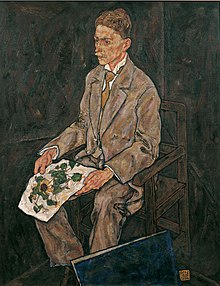

Vienna:
- Albertina : Your graphic collection has a large number of drawings and watercolors by Egon Schiele, and it also maintains the Egon Schiele Archive (Max Wagner Foundation). Some facsimiles are on permanent display in the Habsburg state rooms.
- Belvedere : A first step towards Schiele's current position as one of the most important Austrian painters of the 20th century was the purchase of a portrait of Edith Schiele by the Belvedere in 1918. This first public acquisition of a work by the artist was the pioneering act of the then director Franz Martin Haberditzl, whom Schiele had already portrayed in 1917. He made further acquisitions, which laid the foundation for an extensive and important Schiele collection. Today it comprises 16 paintings, two gouaches and a head bust.
- Leopold Museum : With 41 oil paintings and 186 sheets, the museum houses the world's largest Schiele collection. In 2011 the Egon Schiele Documentation Center was set up in the Leopold Museum (autographs, photographs and literature, compiled by the art collector Rudolf Leopold ). There is an extensive collection of Schiele literature in the museum's library.
- In the Army History Museum there are Schiele sheets in the graphic collection.
- Wien Museum : The municipal museum on Karlsplatz has a Schiele collection, some of which are on permanent display.
Graz:
- Neue Galerie Graz: The Neue Galerie at the Universalmuseum Joanneum owns 20 works by Egon Schiele: 3 oil paintings and 17 graphics (drawings, watercolors, etchings). "End of town / Häuserbogen III", 1918 is in the permanent exhibition.
Tulln:
new York
Krumau:
- Egon Schiele Art Centrum : The Egon Schiele Art Centrum in Krumau in the Czech Republic shows a permanent exhibition about the life and work of the artist. The library has many rare documents and books by and about Egon Schiele.
Train :
- Kunsthaus Zug : The Kunsthaus Zug has an important collection of works from Viennese Modernism through the Kamm Collection Foundation. Including nine oil paintings by Egon Schiele and a good two dozen graphics (etchings, drawings, watercolors) by the artist. In 2018, a permanent loan from the Werner Coninx Foundation expanded the selection of works on paper by a further nine works.
Movies
- Egon Schiele. TV film biography, Austria, BR Germany, 1980, 95 min., Book: Wolfgang G. Fischer , John Goldschmidt, director: John Goldschmidt, music: Gottfried von Eine , production: Schönbrunn-Film, ORF , ZDF , a. a. with Felix Mitterer as Egon Schiele, Karoline Zeisler as Wally Neuzil
- Egon Schiele - excesses . Feature film, Austria, Federal Republic of Germany, France, 1980, 90 min., A. a. with Mathieu Carriere and Jane Birkin , artist portrait, film data at filmportal.de .
- Egon Schiele - The Leopold Collection. TV documentary, Austria, 1994, 45 min., Director: Wolfgang Lesowsky , production: Leopold Museum , Atelier Corinne Hochwarter, Forum Film, (English, German), on Schiele's stations in Vienna, Neulengbach, Krumau , Tulln
- Egon Schiele: Death and Maiden . Feature film, Austria, Luxembourg, 2016, 110 minutes, director: Dieter Berner , based on the biographical novel Death and Girls: Egon Schiele and the Women by Hilde Berger
- Egon Schiele. Documentary with game scenes, Germany, 2017, 55:30 min., Script and director: Herbert Eisenschenk , camera: Helmut Wimmer , production: Vermeer-Film, arte , ORF , first broadcast: October 21, 2018 on arte, summary by ARD .
Musical interpretations
- Rachel’s : Music for Egon Schiele . (1996)
literature
- Austrian Gallery Belvedere (ed.): Egon Schiele - paintings. Exhibition on the 50th anniversary of his death (Austrian Gallery, April 5 - September 15, 1968), Vienna 1968.
- Rudolf Leopold : Egon Schiele. Paintings, watercolors, drawings . Residence, Salzburg 1972.
- Alessandra Comini : Egon Schiele's portraits . University of California Press, Berkeley 1974, ISBN 0-520-06869-6 .
- Erwin Mitsch: Egon Schiele. 1890-1918 . dtv, Munich 1975, ISBN 3-423-01064-9 .
- Christian M. Nebehay : Egon Schiele. 1890-1918. Life, letters, poems . Residence, Salzburg 1979.
- Egon Schiele 1890-1918. Return to Tulln in 1980. Works and documents from the family. Lower Austria Society for Art and Culture, Tulln 1980.
- Egon Schiele. Watercolors and drawings . Kestner-Gesellschaft, Hanover, catalog for the exhibition from April 23 to June 13, 1982.
- Christian M. Nebehay: Egon Schiele. Life and work in documents and pictures. dtv, Munich 1985, ISBN 978-3-423-02884-4 .
- Ludwig Schmidt: Egon Schiele . Berghaus, Kirchdorf 1989, ISBN 3-7635-0122-3 .
- Christian M. Nebehay: Egon Schiele. From the sketch to the picture. The sketchbooks . Christian Brandstätter, Vienna 1989, ISBN 3-85447-320-6 .
- Serge Sabarsky : Egon Schiele. Paintings from American collections . (Austrian Gallery, November 22, 1991 to March 1, 1992), Vienna 1991.
- Karin Thomas (Ed.): Egon Schiele, the Leopold Collection, Vienna . Catalog publication on the occasion of the exhibition Egon Schiele. Leopold Vienna Collection in the Kunsthalle Tübingen , September 2 to December 10, 1995; Art Collection North Rhine-Westphalia , Düsseldorf, December 21, 1995 to March 10, 1996; Hamburger Kunsthalle , March 22 to June 16, 1996 / Rudolf Leopold. DuMont, Cologne 1995, ISBN 3-7701-3474-5 .
- Jane Kallir: Egon Schiele. The complete works. Including a biography and a catalog raisonne. Expanded edition . Harry N. Abrams, New York 1998, ISBN 0-8109-4199-6 .
- Rudolf Leopold: Egon Schiele. The Leopold Collection . DuMont, Cologne 1998, ISBN 3-7701-4585-2 .
- Reinhard Steiner: Schiele. An artist's midnight soul . Taschen, Cologne 1999, ISBN 3-8228-6373-4 .
- Egon Schiele - The Draftsman and Viennese Modernism . Works from the Albertina, Vienna and the Kunsthaus Zug . Writing pad A4, squared, 70 pages with images of all Schiele drawings and a text by Matthias Haldemann.
- Jane Kallir: Egon Schiele. Watercolors and drawings . Edited by Ivan Vartanian, with a foreword by Richard Avedon . Translated from English by Brigitte Hilzensauer, Christian Brandstätter , Vienna 2003, ISBN 3-85498-236-4 .
- Tobias G. Natter , Ursula Storch (Eds.): Schiele & Roessler. The artist and his sponsor. Art and Networking in the Early 20th Century . Hatje Cantz, Ostfildern-Ruit 2004, ISBN 3-7757-1479-0 .
- Leopold Museum Privatstiftung (Ed.): Egon Schiele. Landscapes . Prestel, Munich 2004, ISBN 3-7913-3214-7 .
- Klaus Albrecht Schröder : Egon Schiele. Eros and Passion . Prestel, Munich 2004, ISBN 3-7913-3098-5 .
- Klaus Albrecht Schröder (Ed.): Egon Schiele . Prestel, Munich 2005, ISBN 3-7913-3533-2 .
- Erotic Sketches. Erotic sketches. Egon Schiele. Prestel, Munich 2005, ISBN 3-7913-3431-X . (Afterword by Norbert Wolf , English and German.)
- Renée Price (Ed.): Egon Schiele. The Ronald S. Lauder and Serge Sabarsky Collections . Prestel, Munich 2005, ISBN 3-7913-3390-9 .
- Rudolf Leopold: Schiele, Egon Leo Adolf. In: New German Biography (NDB). Volume 22, Duncker & Humblot, Berlin 2005, ISBN 3-428-11203-2 , pp. 738-741 ( digitized version ).
- Isabel Kuhl: Living Art. Egon Schiele . Prestel, Munich 2006, ISBN 978-3-7913-3703-6 .
- Tobias G. Natter, Thomas Trummer: The round table. Egon Schiele and his group. Masterpieces of early Austrian Expressionism (Österreichische Galerie Belvedere, Vienna, June 14 - September 24, 2006) . DuMont, Cologne 2006, ISBN 3-8321-7700-0 .
- Elisabeth von Samsonow : Egon Schiele - I am the many . Passagen Verlag, Vienna 2010, ISBN 978-3-85165-954-2 .
- Helmut Friedel , Helena Pereña (eds.): Egon Schiele. “Das Unrettbaren Ich” , in: The work in the context of its time. Vienna u. a. 2011, ISBN 978-3-86832-082-4 , (German / English)
- Johann Thomas Ambrózy, Carla Carmona, Eva Werth (eds.): Egon Schiele Jahrbuch , Volume I. Rema-Print Druck- und VerlagsgesmbH, Vienna 2011, ISBN 978-3-200-02512-7 .
- Agnes Husslein-Arco, Jane Kallir: Egon Schiele - self-portraits and portraits (Belvedere Vienna, February 17 - June 13, 2011) . Munich u. a. 2011, ISBN 978-3-7913-5108-7 .
- Elisabeth von Samsonow: Egon Schiele - Sanctus Franciscus Hystericus , Passagen Verlag, Vienna 2012, ISBN 978-3-7092-0063-6 .
- Xavier Coste: Egon Schiele. An excessive life. Knesebeck, Munich 2013, ISBN 3-86873-603-4 .
- Elisabeth von Samsonow (ed.): Egon Schiele as a collector: books and objects from the estate (= Encyclopedia of Viennese Knowledge , Volume XXIII). Edition Seidengasse, Verlag Bibliothek der Provinz , Weitra 2016, ISBN 978-3-99028-561-9 .
- Eric R. Kandel : The Age Of Insight. The Quest To Understand The Unconscious In Art, Mind, And Brain. From Vienna 1900 To The Present . Random House, New York 2012, ISBN 978-1-4000-6871-5 .
- Tobias G. Natter (Ed.): Egon Schiele. All paintings 1909–1918 . Taschen, Cologne 2017, ISBN 978-3-8365-4613-3 .
- Gregor Mayer: I am the eternal child. The life of Egon Schiele. Residence, Salzburg Vienna 2018, ISBN 978-3-7017-3403-0 .
- Hilde Berger : Egon Schiele - Death and Maiden . With an afterword by Dieter Berner as well as script pages and film stills from the film of the same name. Hollitzer Verlag, Vienna 2018, ISBN 978-3-99012-456-7 .
- Leopold Museum (ed.): Egon Schiele. Masterpieces from the Leopold Museum with a prologue by Hans-Peter Wipplinger and texts by Elisabeth Leopold, Rudolf Leopold , Franz Smola and Birgit Summerauer, Verlag der Buchhandlung Walther König, Cologne 2017, ISBN 978-3-96098-080-3 .
- Gerd Presler : From the wrist, Egon Schiele , in: The sketchbook. A stroke of luck in art history , Weingarten / Baden 2017, pp. 138–143, ISBN 978-3-00-056940-1
- Gerd Presler: On the 100th birthday. Egon Schiele as an architect. The mausoleum. In: Weltkunst, October 29, 2018
Web links
- Literature by and about Egon Schiele in the catalog of the German National Library
- Works by and about Egon Schiele in the German Digital Library
- Egon Schiele: Directory of Drawings , e-book of the University Library Vienna ( e-books on demand )
Works
- Works by Egon Schiele at Zeno.org .
- Works by Egon Schiele In: Digitales Belvedere
- Egon Schiele in the database Artcyclopedia (English)
- End of town / Häuserbogen III , 1913/18 in the Neue Galerie Graz
Museums
- World's largest Schiele collection in the Leopold Museum
- Egon Schiele Art Centrum in Cesky Krumlov (German, English, Czech)
Biographies
- Janca Imwolde: Egon Schiele. Tabular curriculum vitae in the LeMO ( DHM and HdG )
- Biography and works. In: Art Directory
- The genealogy of Egon Schiele and his wife
- The wills of Edith and Egon Schiele in the Vienna City and State Archives , accessed on September 22, 2011.
Individual evidence
- ↑ Egon Schiele's birthplace. Retrieved December 19, 2019 .
- ^ Biography Egon Schiele. In: egonschiele.at , Egon Schiele database, accessed on October 22, 2018.
- ^ New Schiele book. In: Niederösterreichische Nachrichten , June 19, 2015.
- ^ Leopold Auer: Egon Schiele und das Heeresmuseum , in: Österreichisches Staatsarchiv (Ed.), Mitteilungen des Österreichisches Staatsarchivs, 26, 1973, p. 456
- ↑ Hannes Steindl: Schiele in the Erlaufschlucht. In: orf.at , May 2, 2016, accessed on October 22, 2018.
- ^ Christian M. Nebehay: Egon Schiele. Life and work in documents and pictures . Munich, Salzburg, Vienna 1983, p. 192.
- ↑ Quoted in: Heeresgeschichtliches Museum (Hrsg.): 100 years Heeresgeschichtliches Museum. Known and unknown about its history . Heeresgeschichtliches Museum, Vienna 1991, p. 15 f.
- ↑ Walter Reichel: "Press work is propaganda work" - Media Administration 1914-1918: The War Press Quarter (KPQ) . Communications from the Austrian State Archives (MÖStA), special volume 13, Studienverlag , Vienna 2016, ISBN 978-3-7065-5582-1 , p. 107 f.
- ↑ Ilse Krumpöck: Anton Faistauer's military uselessness . In: Series of publications on Anton Faistauer and his time . Published by the Anton Faistauer Forum, Maishofen 2007, ISBN 978-3-9502420-0-3 , p. 52, ( Anton Faistauer Forum ).
- ^ Christian Nebehay , Egon Schiele. 1890-1918. Life, letters, poems , Salzburg, Vienna 1979, p. 438.
- ^ Death entry, Vienna City and State Archives, Descriptive Office, B 1, Vol. 1048.
- ↑ Egon Schiele. Ways of a collection. Munich / Vienna 2018, p. 235
- ↑ Complete list of Schilling coins from 1947 to 2001 ( Memento from February 2, 2014 in the Internet Archive ). In: Austrian National Bank (OeNb), p. 34, (PDF; 5.1 MB).
- ↑ Michael Wladika: Dossier Dr. Heinrich Rieger. Provenance research on behalf of the Leopold Museum , December 2009, (PDF), p. 17 f.
- ↑ AFP , dpa , mac: Egon Schiele paintings auctioned for record sums. In: welt.de , June 23, 2011, accessed on October 22, 2018.
- ↑ Online record price for Schiele picture. In: Kurier , June 22, 2013.
- ↑ Online auction record for Andy Warhol Flowers picture. In: artinfo24.com. Retrieved July 20, 2013 .
- ^ Egon Schiele in the Albertina ; Own drawings and watercolors; 345th exhibition 1990.
- ↑ Agnes Husslein-Arco, Jane Kallir: Egon Schiele. Self-portraits and portraits , Munich a. a. 2011, p. 7.
- ↑ Schiele gets a research archive. ( Page no longer available , search in web archives ) Info: The link was automatically marked as defective. Please check the link according to the instructions and then remove this notice. In: orf.at , April 11, 2012.
- ^ Paul-Bernhard Eipper: Four pictures in one picture. For the restoration of Egon Schiele's “End of town / Häuserbogen II / III” . In: Johann Thomas Ambrózy, Carla Carmona, Eva Werth (Eds.): Egon Schiele Yearbook (II / III) 2012/13 . REMA-Print-Littera, Druck- und Verlagsgesellschaft mbH, Vienna 2015, p. 70-94 .
- ^ Johann Thomas Ambrózy, Carla Carmona, Eva Werth (eds.): Egon Schiele Yearbook. Rema-Print, Vienna 2011, accessed on October 22, 2018.
- ^ Egon Schiele and the mausoleum | WORLD ART. In: WELTKUNST, the art magazine of ZEIT. October 29, 2018, accessed March 1, 2020 .
| personal data | |
|---|---|
| SURNAME | Schiele, Egon |
| ALTERNATIVE NAMES | Schiele, Egon Leo Adolf Ludwig |
| BRIEF DESCRIPTION | Austrian expressionist painter |
| DATE OF BIRTH | June 12, 1890 |
| PLACE OF BIRTH | Tulln on the Danube |
| DATE OF DEATH | October 31, 1918 |
| Place of death | Vienna |




